Khanyar Rozabal - The Tomb of Jesus in Kashmir?
Summer 1997, Page 1
| I am the photographer of all these photos. I have seen several of these photos on web sites without credits, links, or permission. If you would like to use any of my photos for your web site or any other reason, please contact me first. Thank you for your kindness and respect. -Ken |
 This
1997 photo I took of Khanyar Rozabal (Kan Yar Rosa Bal), along with six others, can also be found at the
Tomb of
Jesus web site, site of author Abubakr Ben Ishmael Salahuddin, author of
Saving The Savior. This
1997 photo I took of Khanyar Rozabal (Kan Yar Rosa Bal), along with six others, can also be found at the
Tomb of
Jesus web site, site of author Abubakr Ben Ishmael Salahuddin, author of
Saving The Savior.Some scholars and many Kashmirs feel that Jesus is buried here. According to author Holger Kersten and other Western and Kashmiri scholars, it has been a practice of worshippers to place candles around the tombstones. When the centuries-old layers of wax were removed some time ago, an incredible discovery was made -- a pair of footprints had been carved into the stone. This is a common tradition in Asia at the shrines of saints, but still, no one had known that these carved footprints were under the centuries of melted wax! By tradition, footprints were carved to indicate the identity of the deceased, like a fingerprint. These footprints showed the scars of the crucifixion wounds, even indicating by the position of the wounds that the left foot had been nailed over the right, the same as shown on the Turin Shroud! Crucifixion was unknown as a form of death penalty in India. Also found were a crucifix and, rosary. Along with the scars of the crucifixion wounds on the footprints, these were a startling discovery! Scholars also noted that the tomb is oriented in a Jewish manner, not in a Hindu or Islamic manner. |
|
Many places and towns along the road that Jesus allegedly took to Kashmir are named after him. This includes the town of Mari (Murree) near Kashmir, where a grave known as Mai Mari da Asthan ("The Final Resting Place of Mother Mary"), a Jewish-style east-west oriented tomb revered by the local population as the mother of Jesus (or Issa, as Jesus is known in Islam) by the local population, according to Holger Kersten. Continuing on the road to Kashmir, one passes a broad open valley named "Yus-Marg", or "Meadow of Jesus", where the local shepherd tribes called Bani-Israel ("The Children of Israel") who live there say that Jesus once preached, according to Holger Kersten's book. |
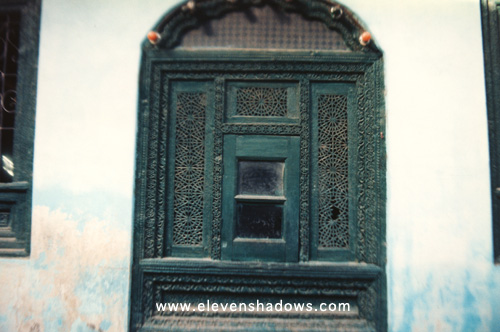 From the street, many passersby stop to say a short prayer at
this window at the tomb before continuing on. Peering into this
window, one could see the sarcophagus of Yuz Asaf ((Yuz Asaf, Yus
Asaf,Youza Asouph, or Issa to Kashmiris and Persians). From the street, many passersby stop to say a short prayer at
this window at the tomb before continuing on. Peering into this
window, one could see the sarcophagus of Yuz Asaf ((Yuz Asaf, Yus
Asaf,Youza Asouph, or Issa to Kashmiris and Persians).This photo, along with many others, can also be found on the Tomb of Jesus web site. When I visited in 1997, I was told by locals that the tomb has been tended by the same family since AD 112, the position of tomb attendant being passed down in an unbroken line from father to son. Some journalists report that the people watching the tomb have been hired by the ancestors of this original family. |
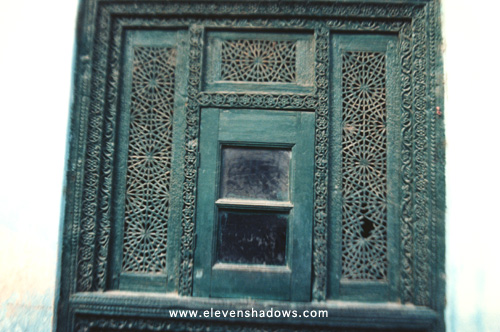 A closer look at the details of the window
from the street in Khanyar Rozabal. A closer look at the details of the window
from the street in Khanyar Rozabal.This is a new photo which I have never before shown the public (as of June 1, 2007). Are there Indian texts that tell of Jesus in India? The ancient Sanskrit narratives of the Hindus are called the Puranas. According to Kersten and Professor Hassnain, the ninth volume, Bhavishyat Maha-Purana, written between the third and seventh centuries AD, contains a description of Jesus coming to India. The text tells how Israelites came to live in India, and then tells of how a king in India met a man with a "white body" wearing white garments. The King asked who he was, and the man replied, "Know that I am Ishaputra ("Son of God"), born of a virgin, proclaimer of the teachings of the barbarians (Mleccha) which bear the truth. I appeared as Masiha (The Messiah) in the depraved land of the unbelievers." He also says that "man will find his way to Isha ("God") and also refers to himself as Isha-Masiha ("The Lord, the Messiah"). There is no comparable legend found before this in Indian literature, according to Kersten. |
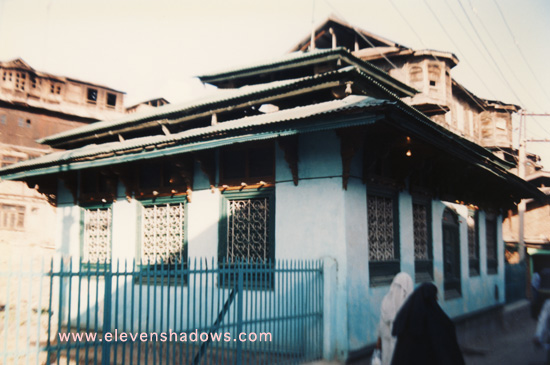 The back side of Khanyar Rozabal, as seen from the street.
This photo, like many of the others, also appears on the
Tomb of
Jesus web site. The back side of Khanyar Rozabal, as seen from the street.
This photo, like many of the others, also appears on the
Tomb of
Jesus web site.~~ About the camera: |
 The front entrance to Khanyar Rozabal. This
is one of numerous photos I've taken which appear in the
Tomb of
Jesus web site gallery. The front entrance to Khanyar Rozabal. This
is one of numerous photos I've taken which appear in the
Tomb of
Jesus web site gallery. |
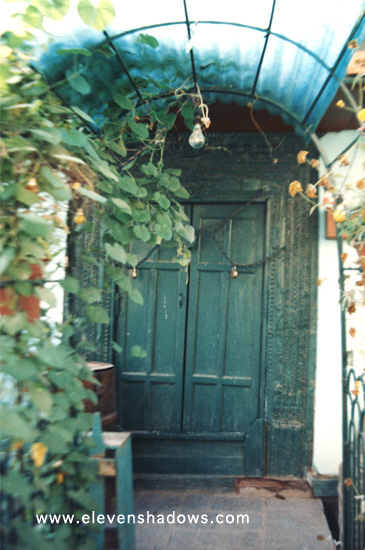 Entrance to Khanyar Rozabal,
Srinagar, Kashmir. Entrance to Khanyar Rozabal,
Srinagar, Kashmir. |
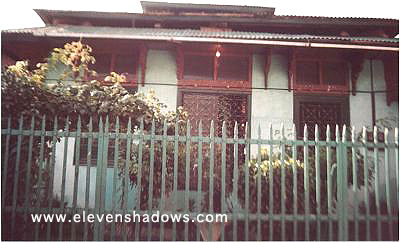 Side view of Khanyar Rozabal (Khanyar Rosa Bal). This
photo was taken from the
Tomb of
Jesus web site gallery - oddly, I can't seem to find the negative of
this at the moment. Side view of Khanyar Rozabal (Khanyar Rosa Bal). This
photo was taken from the
Tomb of
Jesus web site gallery - oddly, I can't seem to find the negative of
this at the moment. |
 Close-up of the entrance to Khanyar Rozabal
(Khanyar Rosa Bal). This photo was taken from the
Tomb of
Jesus web site gallery - oddly, I can't seem to find the negative of
this at the moment. Close-up of the entrance to Khanyar Rozabal
(Khanyar Rosa Bal). This photo was taken from the
Tomb of
Jesus web site gallery - oddly, I can't seem to find the negative of
this at the moment.There are literally dozens of books from Asia, including Kashmir, that seem to indicate that Kashmiris are actually descendants of Israelites, supporting the theory that they may be indeed the Ten Lost Tribes of Israel. Although now converted to the Muslim religion, there are apparently many similarities linguistically, culturally, and artistically between Israelites and Kashmiris. |
|
In Tarikh-i-Kashmir ("History of Kashmir"), written in 1420, historian Mullah Nadiri writes that the structure, already a thousand-year old Hindu structure, was restored by a Persian architect during the reign of Raja Gopadatta (79-109 AD). During the renovation, the following was inscribed on the steps in Old Persian:
Dar een wagat yuz asaf dawa-i-paighambar-imikunad.
Sal panjah wa chahar.
Aishan yuzu paighambar-i-bani israil ast. Mullah Nadiri further writes: In a Hindu work it is said that this Prophet was in reality Hazrat Issa (the Muslim name for Jesus), the Soul of God - on whom be peace and salutations. He had assumed the name of Yuz Asaf during his life in the valley. The real knowledge is with God. After his passing, Hazrat Issa was laid to rest in Anzimar (where Khanyar Rozabal is) -from "A Search for The Historical Jesus" by Professor Fida Hassnain). The inscriptions of the temple have been destroyed, but according to Prof. Hassnain, were recorded by other Kashmiri historians, including Mirza Haider Malik Chaudura, Mufti Ghulam Nabi Khanyari, and Pirzada Ghulam Hassan Khuyami, whose Persian works are preserved at the Oriental Manuscript Library, the University of Kashmir, and other libraries in Srinagar. A pillar next to the temple was torn down in the early 1970s by the Indian Army to make room for military structures, and a Srinagar TV tower is perched on the top of the hill.. This temple was also re-converted to a Hindu temple at about the same time. Sultan, the man who took me up to Takht-i-Suleiman, hadn't been up to the top of the hill in 30 years. When we got to the top, he looked around, puzzled, and pointed to the spot where the pillar used to be. Now, only a large circle remained, surrounded by Indian army military structures. Sultan looked at me, then away, and mumbled, "Why do they do these things?" ~~~ I hiked up Shankaracharya Hill when I visited later in 2005. This time, however, there were thousands of Hindu pilgrims celebrating and waiting in long lines to climb up the stairs to the temple. Not having enough time, I stayed by the road, eating with the Hindu pilgrims (it's impossible not to, as food is thrust upon you at every opportunity), admiring the views of Dal Lake and Hazratbal Mosque, which houses a hair of Prophet Mohammad. |
The photo of Takht-i-Suleiman
will appear in the
June/July 2007
Four Corners Magazine.Many of the descriptions and photos of the 1997 trip to Kashmir originally appeared here.
Khanyar Rozabal Home Page
Eleven Shadows Travel Page
Image of
Shroud of Turin by...Johnny Cash?
alternate spellings for Khanyar Rozabal and Yuz Asaf: Kan Yar Rosa Bal, Rauza Bal; Youza Asouph, Yuz Assaf, Yus Asaf, युझ असफ, یوذسف), Judasaf, Yus Asaph, or Shahzada Nabi Hazrat Yura Asaf